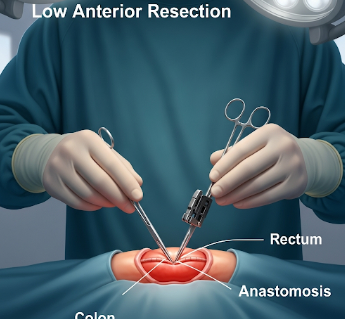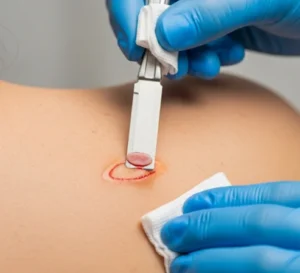Overview
Low Anterior Resection (LAR) is a surgical procedure performed to remove the lower part of the colon and rectum, typically for patients with rectal cancer, polyps, or other colorectal conditions. The goal is to eliminate diseased tissue while preserving bowel function, including continence.
In Korea, LAR is performed by expert colorectal surgeons using advanced techniques like laparoscopic or robotic-assisted surgery, which reduce recovery time, minimize complications, and preserve quality of life.
Highlights:
- ✅ Removes diseased lower colon or rectum
- ✅ Preserves bowel function and continence
- ✅ Advanced minimally invasive techniques available in Korea
What is Low Anterior Resection?
Low Anterior Resection involves the surgical removal of the diseased section of the rectum and sigmoid colon, followed by reconnection (anastomosis) of the remaining bowel.
Indications include:
- Rectal cancer in the mid or upper rectum
- Large polyps or precancerous lesions
- Diverticular disease or chronic inflammatory bowel disease affecting the rectum
Important: The procedure aims to remove all diseased tissue while maintaining sphincter function, avoiding the need for permanent colostomy whenever possible.
What are the benefits?
- Curative treatment: Removes cancerous or diseased tissue
- Preserves bowel continuity: Most patients retain normal bowel function
- Minimally invasive options: Laparoscopic or robotic-assisted techniques reduce pain and recovery time
- Improved quality of life: Avoids permanent colostomy in many cases
Key benefits highlighted:
- ⚡ Reduces risk of disease recurrence
- ⚡ Preserves natural bowel function
- ⚡ Shorter hospital stay and faster recovery
- ⚡ Suitable for both adult and elderly patients
Procedure Details
1) How should I prepare for Low Anterior Resection?
- Preoperative evaluation: Blood tests, colonoscopy, imaging (CT or MRI), and cardiopulmonary assessment
- Bowel preparation: Laxatives or enemas to clear the bowel
- Medication review: Adjust anticoagulants or other medications as instructed
- Consent and education: Discuss risks, benefits, recovery, and possible temporary stoma
- Lifestyle preparation: Healthy nutrition and cessation of smoking for better healing
2) What happens during Low Anterior Resection?
- Anesthesia: General anesthesia administered
- Surgical approach: Open, laparoscopic, or robotic-assisted access to the rectum and lower colon
- Resection: Diseased bowel segment is removed
- Anastomosis: Remaining ends of the colon are reconnected to restore continuity
- Closure: Incisions closed with sutures or staples; temporary stoma may be created if necessary
Duration: Typically 2–4 hours depending on complexity and surgical approach
3) What happens after Low Anterior Resection?
- Recovery monitoring: Vital signs, bowel function, and incision healing closely observed
- Pain management: Medications administered as needed
- Diet progression: Gradual return to normal diet as bowel function resumes
- Follow-up care: Regular monitoring for complications and bowel function assessment
Highlights for post-operative care:
- ⚡ Monitor for signs of infection or leakage at anastomosis
- ⚡ Early mobilization to prevent blood clots and improve bowel function
- ⚡ Adhere to dietary recommendations
- ⚡ Attend scheduled follow-up visits for optimal recovery
Risks / Benefits
Risks:
- Infection or wound complications
- Anastomotic leak (rare but serious)
- Bleeding or bowel obstruction
- Temporary or permanent changes in bowel habits
Benefits:
- Removes diseased tissue effectively
- Preserves bowel continuity and sphincter function
- Minimally invasive options reduce recovery time
- Improved long-term survival and quality of life in cancer cases
Recovery and Outlook
- Hospital stay: Usually 5–10 days depending on surgical approach and recovery
- Full recovery: 4–6 weeks for most patients; return to normal activities gradually
- Long-term outlook: Excellent outcomes when performed by experienced colorectal surgeons; regular monitoring ensures early detection of recurrence
- Follow-up: Colonoscopy, imaging, and lab tests as advised for ongoing monitoring
Tips for optimal recovery:
- ✅ Follow dietary and bowel care instructions
- ✅ Engage in light physical activity as permitted
- ✅ Monitor incision for redness, swelling, or discharge
- ✅ Keep all follow-up appointments for long-term monitoring
When To Call the Doctor
- Fever, chills, or signs of infection
- Severe abdominal pain or persistent vomiting
- Changes in bowel habits or unusual bleeding
- Leakage from stoma or surgical site (if temporary stoma created)
Best Korea Option / Process
Korea provides advanced Low Anterior Resection care:
- Top hospitals: Specialized colorectal surgery teams with minimally invasive expertise
- Advanced diagnostics: Colonoscopy, CT, MRI, and tumor staging for precise planning
- Surgical options: Laparoscopic and robotic-assisted LAR for faster recovery
- Postoperative care: Pain management, diet progression, and bowel function monitoring
- International patient support: Online consultations, appointment scheduling, and telemedicine follow-up
Step-by-step process in Korea:
- Online consultation and preoperative evaluation
- Bowel preparation and medical optimization
- Low Anterior Resection performed using minimally invasive techniques
- Postoperative monitoring, pain management, and diet progression
- Long-term follow-up to assess bowel function and detect recurrence













